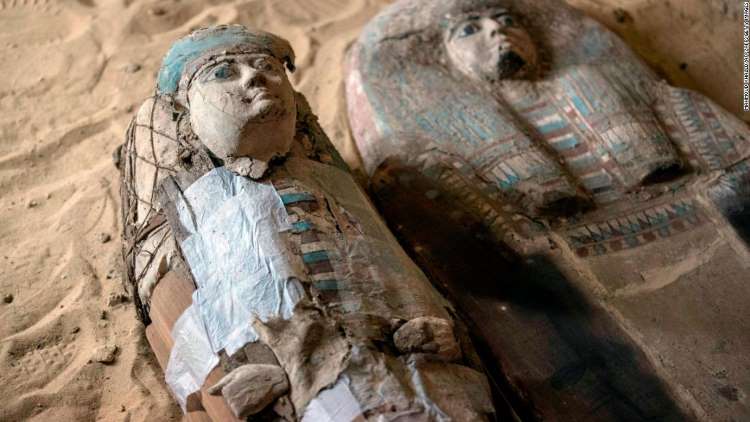Treasure Trove of Discoveries Unearthed in Egypt’s Saqqara Necropolis
Situated some 30 km (19 miles) south of modern Cairo and the house of the older and the most early documented pyramid is Saqqara’s enormous historic site, the Unas, the well-known Step Pyramid of Djoser, the Serapeum, and the tomb of the spiritual Apis bulls, varying from the early Old Kingdom to the Graeco-Roman period.
In December 2018, The BBC reported archaeologists at Saqqara had actually found an “exceptionally-well preserved” burial chamber, the Wahti Burial place, consisting of holy birds and mummified animals, and now, the Tourist and Antiquities Minister in Egypt, Khaled El-Enany, revealed on Saturday through Instagram a brand-new discovery at the Spiritual Animal Necropolis in Saqqara near the highly-decorated burial place of “Wahti and the cachette” of spiritual birds and animals, reports Egypt Today.
The Minister of Tourist and Antiquities published pictures of himself with excavation employees in Saqqara on his main Instagram account revealing his group checking out a “burial well” situated beside the Wahti Burial place.

The archaeologists discovered a passage that caused a chamber real estate 5 closed limestone sarcophagi and 4 wood caskets, all with human mummies within, from the Late Pharaonic Period.
In among the specific niches a big human-shaped wood sarcophagus included engravings in intense yellow ink and around it was a big collection of statues and pottery consisting of “365 Ushabti statues” crafted in faience and some including hieroglyphs A little wood obelisk measuring 40 cm (16 inches) in height was likewise found, and when this artifact is translated with the ushabtis themselves, they together use insight into ancient Egyptian cosmology.
The ushabti, shabti, or shawabti was a funerary figurine utilized within the death routines of ancient Egyptian faith, and they were positioned in burial places amongst the spiritual serious items meant to serve the deceased in the afterlife.

The routine application of ushabtis came from the Old Kingdom of Egypt ( c. 2600 to 2100 BC) and frequently they were portrayed with a hoe over their shoulders bring baskets on their backs.
Archaeologists believe these signs insinuate a belief that the statuettes would amazingly come to life and farm for the departed, and according to Richard Taylor’s 2000 paper’ Shabti, Ushabti, Shawabti, Death and the Afterlife’, hieroglyphs normally appeared on the legs asserting “their readiness to answer the gods’ summons to work.”
What is unique about the recently found collection of ushabti is that there are 365, one for each day of the year.
A short article on Ancient Egypt Online discusses that while the lunar calendar was utilized to determine dates for spiritual celebrations and routines, daily life was structured around the solar calendar of 365 days annually.
Each year consisted of 3, four-month seasons, which were called after considerable occasions associated with their agrarian way of life.
Obelisks, or pyramidions, were frequently set up outdoors as landmarks or monoliths representing the power and consistency of the Sun god Ra. Nevertheless, throughout the spiritual reformation of Akhenaten, the sign was translated as a scared ray of the Sun god Aten (sundisk) representing the god’s presence within the stone body of the structure.

Obelisks were normally set up to honor occasions or people, honoring the gods for the associated successes and according to Ancient Encyclopedia, the ancient Egyptians began producing obelisks eventually in the Early Dynastic Duration (c. 3150-2613 BC) prior to the building and construction of the Action Pyramid of Djoser ( c. 2670 BC).
It is believed that the earliest obelisks worked as a sort of training for operating in stone on huge jobs, which was an essential action towards pyramid structure.
However, in the context that the brand-new 40 cm (16 inches) high design was found, in the middle of 365 ushabti, it represents the Sun, and its associated god, the magnificent Ra.
The secretary and therapist of the Sun god Ra were Thoth, who according to Ancient Egypt Online was “the One who Made Calculations Concerning the Heavens, the Stars and the Earth” and “the Reckoner of Time and of Seasons” – the “inventor of the 365-day calendar,” which changed the unreliable 360-day calendar.
Together, the 365 ushabti and the obelisk represent the days of the solar year and the Sun of this world, and it is gorgeous to see them surrounding the casket of somebody who is now under the light of another Sun, in another location and time.
